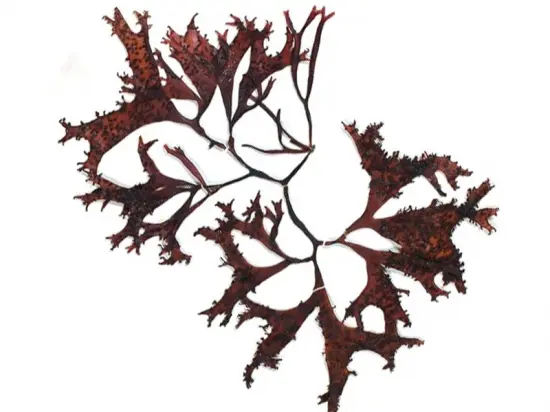
Mastocarpus stellatus
- Vitamin A
- Sugar
- Minerals
- Antioxidants
On request

Introduction: Mastocarpus stellatus
What is Mastocarpus stellatus?
Mastocarpus stellatus is a macroalgae which belongs to the red algae. It is also known under the common names of kelp and needle kelp.
Where is Mastocarpus stellatus found?
Mastocarpus stellatus is mainly found in the coastal regions around Great Britain and Scotland, where it has been used for various purposes for a long time. However, Mastocarpus stellatus is not restricted to these regions. The macroalga is generally found more often in cold northern waters, where its frost tolerance gives it a great advantage over other macroalgae.
This does not mean that Mastocarpus stellatus is dependent on these colder waters and can only be found there. Mastocarpus stellatus can also be encountered in the Mediterranean Sea.
What is the difference between Mastocarpus stellatus and Chondrus crispus?
Mastocarpus stellatus and Chondrus crispus have some things in common - both macroalgae belong to the red algae species and also share a similar appearance.
When it comes to appearance, there are some differences that help trained eyes to separate the two macroalgae when looking at them. Especially around the stems and fronds, there are contrasts that could be helpful in differentiation.
The differences do not end with appearance. The two red algae are each adapted to different habitats. While they can both occur simultaneously in some locations, Mastocarpus stellatus is more frost and cold tolerant, which allows it to grow in places where Chondrus crispus has difficulty. Conversely, Mastocarpus stellatus can grow in milder places where Chondrus crispus is more abundant, but it is often outcompeted there by Chondrus crispus.
These external differences aside, it stands to reason that the nutrient profiles of the two macroalgae are structured differently, as they are different genera and species.
What are the advantages of Mastocarpus stellatus?
Mastocarpus stellatus, according to studies, can be a good aid in detoxifying the body, acting as an antioxidant and thus neutralizing free radicals[3, 4].
Due to its intertidal habitat, Mastocarpus stellatus is often exposed to sun and UV radiation. In response, evolution has allowed the macroalgae to form molecules that protect it from UV radiation[6]. This makes it an interesting supplement for sun protection.
These are just some of the benefits that the multitude of studies suggest, and the rush will not let up anytime soon.
When can Mastocarpus stellatus be used, and in what applications?
Mastocarpus stellatus can be used for a variety of applications and is also already widely used.
The oldest and probably most common use is as an ingredient for food and as an ingredient in recipes. Due to its many, healthy ingredients, Mastocarpus stellatus has been popular as a nutritious supplement for centuries.
The cosmetics industry also appreciates the nutritional profile of Mastocarpus stellatus and uses the macroalgae in a variety of products. Mastocarpus stellatus is good at neutralizing free radicals as an antioxidant while remineralizing the skin. Mastocarpus stellatus is also an interesting option as a complementary agent for UV protection[3, 4. 6, 7, 8].
In the field of medicine and dietary supplements, Mastocarpus stellatus holds a multitude of potential benefits, which are currently still being actively tested and evaluated.
Can Mastocarpus stellatus be eaten?
Yes, Mastocarpus stellatus is edible and has been used for centuries in some regions as an ingredient in various recipes.
Typical applications: Mastocarpus stellatus
Typical applications
Mastocarpus stellatus, also known as “false Irish moss”, is a red algae that occurs on many different European coasts.
The needle seaweed is excellent for preparing salads, sauces and marinades.
But Mastocarpus stellatus also has something to offer for the skin. Due to its rich content of sugar and vitamin A it has a soothing effect on the skin and at the same time protects it from drying out[6, 7, 8].
The powder is commonly used for food.
Typical applications in the cosmetics industry:
Mastocarpus stellatus has antioxidant properties and thus protects the skin from external influences as well as oxidative stress[3, 4].
Mastocarpus stellatus can help improve the texture of the skin and thus better maintain the overall appearance of the skin[7].
Sources:
- Mastocarpus stellatus - M.D. Guiry in Guiry, M.D. & Guiry, G.M. 17 February 2020. AlgaeBase. World-wide electronic publication, National University of Ireland, Galway. (https://www.algaebase.org/search/species/detail/?species_id=24)
- Mastocarpus stellatus - Wikipedia (https://en.wikipedia.org/wiki/Mastocarpus_stellatus)
- Gómez-Ordóñez E, Jiménez-Escrig A, Rupérez P. Effect of the red seaweed Mastocarpus stellatus intake on lipid metabolism and antioxidant status in healthy Wistar rats. Food Chem. 2012 Nov 15;135(2):806-11. doi: 10.1016/j.foodchem.2012.04.138. Epub 2012 May 7. PMID: 22868162. (https://pubmed.ncbi.nlm.nih.gov/22868162/)
- Lohrmann NL, Logan BA, Johnson AS. Seasonal acclimatization of antioxidants and photosynthesis in Chondrus crispus and Mastocarpus stellatus, two co-occurring red algae with differing stress tolerances. Biol Bull. 2004 Dec;207(3):225-32. doi: 10.2307/1543211. PMID: 15616353. (https://pubmed.ncbi.nlm.nih.gov/15616353/)
- McDonnell A, Luck T, Nash R, Touzet N. Biochemical profiling and antioxidant activity analysis of commercially relevant seaweeds from northwest Europe. J Sci Food Agric. 2024 Aug 30;104(11):6746-6755. doi: 10.1002/jsfa.13501. Epub 2024 Apr 9. PMID: 38551463. (https://pubmed.ncbi.nlm.nih.gov/38551463/)
- Bischof, Kai & Kräbs, G. & Dieter, Hanelt & Wiencke, Christian. (2000). Photosynthetic characteristics and mycosporine-like amino acids under UV radiation: A competitive advantage of Mastocarpus stellatus over Chondrus crispus at the Helgoland shoreline?. Helgol. Mar. Res.. 54. 47-52. 10.1007/s101520050035. (https://www.researchgate.net/publication/225534453)
- González-Ballesteros N, Torres MD, Flórez-Fernández N, Diego-González L, Simón-Vázquez R, Rodríguez-Argüelles MC, Domínguez H. Eco-friendly extraction of Mastocarpus stellatus carrageenan for the synthesis of gold nanoparticles with improved biological activity. Int J Biol Macromol. 2021 Jul 31;183:1436-1449. doi: 10.1016/j.ijbiomac.2021.05.115. Epub 2021 May 21. PMID: 34023369. (https://pubmed.ncbi.nlm.nih.gov/34023369/)
- Cid, U., Rodríguez-Seoane, P., Díaz-Reinoso, B., & Domínguez, H. (2021). Extraction of Fatty Acids and Phenolics from Mastocarpus stellatus Using Pressurized Green Solvents. Marine Drugs, 19(8), 453. (https://doi.org/10.3390/md19080453)
Reply within twelve hours